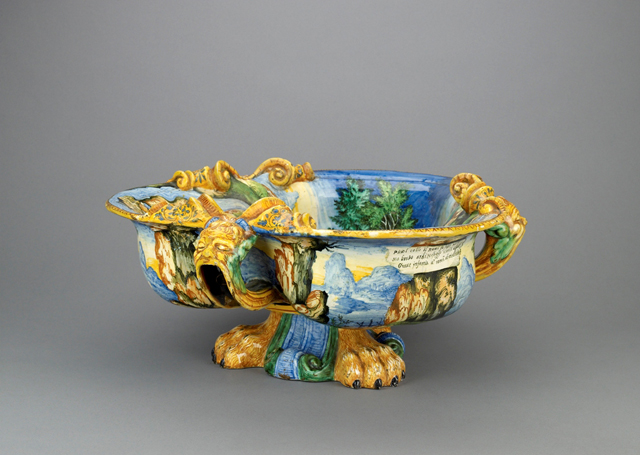Browse Collection
8 of 236

Wine cooler with a story from Roman history
Durantino (alias Fontana) Guido
Urbino, c. 1550 - 1560
48.cm (width); 22.5cm (depth)
tin-glazed earthenware (maiolica)
The deep trilobed basin, which has three satyr-mask handles and three lion-paw feet, is of the form called in the Renaissance and to the present day a rinfrescatoio, and was used as a wine-cooler. It seems to have been introduced into Urbino maiolica (perhaps from silver, though no surviving silver example is known) by around 1540 and became a focal object in large table services.
Several columns of soldiers march through a rocky landscape. On a fictive sheet of paper on the side is the inscription:
picciol colle il Roma[no] susidio tiene
ma bruto ardito e saggio il mo[n]te assale
grave infamia à roma[n] co[n] minor bene
{A little hill holds the Roman reinforcements
but Brutus, brave and clever, attacks the mountain -
a severe disgrace for the Roman[s] with little advantage).
The manner of painting and the use of verse explanations strongly recalls the series made, probably in the Fontana workshop, with subjects from the Punic Wars (see, for instance R.E.A. Drey, "Istoriato maiolica with scenes from the Second Punic War. Livy's history of Rome as source material", in T. Wilson (ed.), Italian Renaissance Pottery, London, 1991, pp. 51 61; and T. Wilson, Italian Maiolica of the Renaissance (Milan, 1996), pp. 290-2. The painter who carried out most of the Hannibal service may also have painted this basin. One might have expected, if it were not for the mention of Brutus in the inscription, this basin to be from the Punic War series. If not, it may be an exceptional survival of a parallel service with stories of the Roman Civil War, though even in that case the episode remains unidentified.
A basin almost identical to this one is in the Speed Museum of Art, Louisville, Kentucky: see A. Ladis, Italian Renaissance Maiolica from Southern Collections, exhib. cat., Georgia Museum of Art, Athens, Georgia, 1989, no. 24. The inscription on the Speed Museum cooler was probably identical to that on the present one, but is only partly legible, having run in the kiln. It is possible that the present one replaced the Speed Museum one because of the kiln defect. No other pieces which seem likely to be from the same set have been noted.
Lent from a private collection. LI192.3

Click to hide image
Other Images

Click to hide image

Click to hide image

|

|